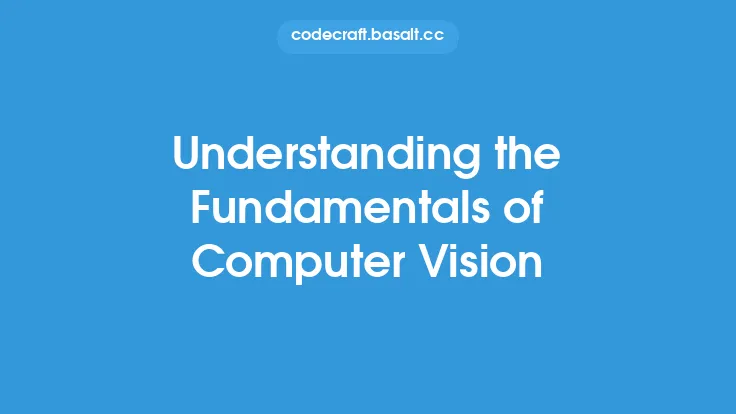Geometric transformations and feature extraction are fundamental concepts in computer vision, enabling machines to interpret and understand visual data from the world. These concepts form the backbone of various computer vision applications, including image processing, object recognition, and scene understanding. In this article, we will delve into the world of geometric transformations and feature extraction, exploring their principles, techniques, and applications in computer vision.
Introduction to Geometric Transformations
Geometric transformations refer to the process of altering the spatial relationships between pixels or points in an image. These transformations can be used to correct for distortions, change the perspective, or enhance the visual representation of an image. There are several types of geometric transformations, including translation, rotation, scaling, and affine transformations. Translation involves shifting an image by a certain amount in the x and y directions, while rotation involves rotating an image by a certain angle around a fixed point. Scaling, on the other hand, involves resizing an image by a certain factor, and affine transformations involve a combination of translation, rotation, and scaling.
Types of Geometric Transformations
There are several types of geometric transformations, each with its own unique characteristics and applications. Rigid transformations, such as translation and rotation, preserve the shape and size of an object, while non-rigid transformations, such as scaling and affine transformations, can alter the shape and size of an object. Projective transformations, such as perspective projection, can be used to model the way a 3D scene is projected onto a 2D image. These transformations are essential in computer vision, as they enable machines to correct for distortions, change the perspective, and enhance the visual representation of an image.
Feature Extraction Techniques
Feature extraction is the process of selecting and extracting relevant information from an image, such as edges, lines, and shapes. This information can be used to describe the visual content of an image, enabling machines to recognize objects, scenes, and activities. There are several feature extraction techniques, including edge detection, line detection, and shape detection. Edge detection involves identifying the boundaries between different regions in an image, while line detection involves identifying the lines and curves that make up an image. Shape detection, on the other hand, involves identifying the shapes and objects that are present in an image.
Image Features and Descriptors
Image features and descriptors are used to describe the visual content of an image, enabling machines to recognize objects, scenes, and activities. There are several types of image features and descriptors, including pixel values, gradient orientations, and texture patterns. Pixel values refer to the intensity values of each pixel in an image, while gradient orientations refer to the direction of the gradient at each pixel. Texture patterns, on the other hand, refer to the arrangement of pixels in an image, such as the pattern of lines and curves. Image features and descriptors can be used to describe the visual content of an image, enabling machines to recognize objects, scenes, and activities.
Geometric Transformations and Feature Extraction in Practice
Geometric transformations and feature extraction are essential in various computer vision applications, including image processing, object recognition, and scene understanding. In image processing, geometric transformations can be used to correct for distortions, change the perspective, and enhance the visual representation of an image. Feature extraction techniques, such as edge detection and line detection, can be used to identify the boundaries and shapes that are present in an image. In object recognition, geometric transformations and feature extraction can be used to recognize objects, regardless of their position, orientation, and scale. In scene understanding, geometric transformations and feature extraction can be used to recognize scenes and activities, such as recognizing a person walking or a car driving.
Applications of Geometric Transformations and Feature Extraction
Geometric transformations and feature extraction have numerous applications in computer vision, including image processing, object recognition, scene understanding, and robotics. In image processing, geometric transformations can be used to correct for distortions, change the perspective, and enhance the visual representation of an image. Feature extraction techniques, such as edge detection and line detection, can be used to identify the boundaries and shapes that are present in an image. In object recognition, geometric transformations and feature extraction can be used to recognize objects, regardless of their position, orientation, and scale. In scene understanding, geometric transformations and feature extraction can be used to recognize scenes and activities, such as recognizing a person walking or a car driving. In robotics, geometric transformations and feature extraction can be used to enable robots to navigate and interact with their environment.
Conclusion
In conclusion, geometric transformations and feature extraction are fundamental concepts in computer vision, enabling machines to interpret and understand visual data from the world. These concepts form the backbone of various computer vision applications, including image processing, object recognition, and scene understanding. By understanding the principles and techniques of geometric transformations and feature extraction, developers can build more sophisticated computer vision systems that can recognize objects, scenes, and activities, and interact with their environment in a more intelligent and autonomous way. As computer vision continues to evolve and improve, the importance of geometric transformations and feature extraction will only continue to grow, enabling machines to see and understand the world in a more detailed and nuanced way.





